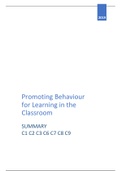Samenvatting
Samenvatting (summary) - Promoting behaviour for learning in the classroom H1, H2, H3, H6, H7, H8, H9
- Instelling
- Hogeschool Windesheim (HW)
Samenvatting van de hoofdstukken 1, 2, 3, 6, 7, 8 en 9 van het boek 'Promoting behaviour for learning in the classroom' van Simon Ellis en Janet Tod (ISBN 978-0-415-70449-6). Deze hoofdstukken zijn voorgeschreven literatuur voor de module 'Stimuleren van leergedrag', ook wel STIMU (ENSO-STIMU.XX....
[Meer zien]





